|
 Belarus
Video Download Page Belarus
Video Download Page
25 Sep 2009
All 17 chapters now on line
17 HD Chapters on line
The videos provide a variety of information concerning the people, their
environment, and their culture as well as how you can become involved in
reaching the peoples of Belarus for Christ. A brief summary
of each of the chapters is provided below.
Click on the file type for
downloading. The mp4-S is a one half resolution and the
mp4-L is the full resolution format. The HD-1080 and the
HD-720 are mp4 files in the High Definition format.
Find out more about mp4
videos and how to download, save and view these videos.
See
additional information at the bottom of this page.
|
The Belarusians: A People
Seeking Hope
Filmed September 2006
Belarus, a country about the size
of Kansas, USA, is strategically located on the Eastern edge of
Europe and only 400 miles from Moscow. It was part of the Soviet
Union until 1991. The first few years after independence were
characterized by personal freedom unknown to Belarusian’s. They
could move about within the country without fear of the intrusion
from secret police and were free to worship and praise their God.
The evangelical Believer could now openly share their faith with
others. But this freedom of religion was short lived. A new
president was elected who rewrote the constitution and enacted
laws that curtailed much of the free press. Additional laws have
made it difficult to share one’s faith or to start new evangelical
churches.
|
|
Hope for the Belarusians
The desire is
for all of the Belarusians to understand this proclamation: “God
is Love” and to know personally that God IS the source of love, peace, joy, … hope.
|
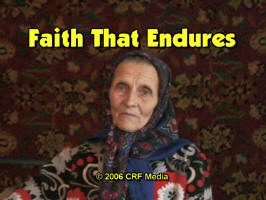 Faith
That Endures: 10:00 (HD-720;
mp4-SW;
mp4-LW;
Script)
The Gospel was brought to Belarus some 200
years ago and by the late 1920’s, many evangelical churches were
started, even in the midst of Vladimir Lenin becoming ruler of
what became known as the Soviet Union. This was a difficult time
for Christians since Lenin proclaimed that there is no God.
Religious meetings were banned and the once influential Russian
Orthodox Church rapidly decayed. Faith
That Endures: 10:00 (HD-720;
mp4-SW;
mp4-LW;
Script)
The Gospel was brought to Belarus some 200
years ago and by the late 1920’s, many evangelical churches were
started, even in the midst of Vladimir Lenin becoming ruler of
what became known as the Soviet Union. This was a difficult time
for Christians since Lenin proclaimed that there is no God.
Religious meetings were banned and the once influential Russian
Orthodox Church rapidly decayed. |
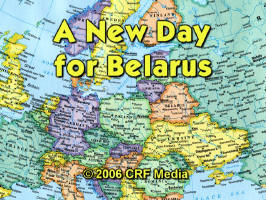 A
New Day for Belarus: 6:00
(HD-720;
mp4-SW;
mp4-LW;
Script) It
is becoming increasingly difficult to establish new evangelical
churches and Bible studies. Gaining government approval for
meetings and a meeting place is difficult particularly in the
rural areas where there are very few Believers. Evangelical
Believers represent less than one percent of the population and
are considered a cult by the government and by the Orthodox
Church. Nevertheless, many have a deep and enduring faith in
Jesus. Those who seek to share their faith and to establish new
churches continue on their journey despite the obstacles placed in
their path. A
New Day for Belarus: 6:00
(HD-720;
mp4-SW;
mp4-LW;
Script) It
is becoming increasingly difficult to establish new evangelical
churches and Bible studies. Gaining government approval for
meetings and a meeting place is difficult particularly in the
rural areas where there are very few Believers. Evangelical
Believers represent less than one percent of the population and
are considered a cult by the government and by the Orthodox
Church. Nevertheless, many have a deep and enduring faith in
Jesus. Those who seek to share their faith and to establish new
churches continue on their journey despite the obstacles placed in
their path. |
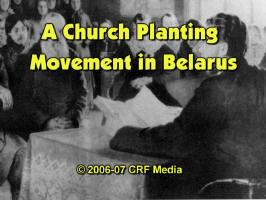 A
Church Planting Movement in Belarus: 15:30
(HD-720;
mp4-SW;
mp4-LW;
Script) It
was in the late 1800’s and the early 1900’s that an evangelical
church planting movement was underway in Russia. Missionaries
from the Baltic region, Germany, Ukraine and Georgia began the
spread of the Gospel of faith and holiness. This message
continued an eastward progression all the way to the Pacific
Ocean. In less than 60 years, the movement grew from no Baptist
Believers to over 600,000. A
Church Planting Movement in Belarus: 15:30
(HD-720;
mp4-SW;
mp4-LW;
Script) It
was in the late 1800’s and the early 1900’s that an evangelical
church planting movement was underway in Russia. Missionaries
from the Baltic region, Germany, Ukraine and Georgia began the
spread of the Gospel of faith and holiness. This message
continued an eastward progression all the way to the Pacific
Ocean. In less than 60 years, the movement grew from no Baptist
Believers to over 600,000. |
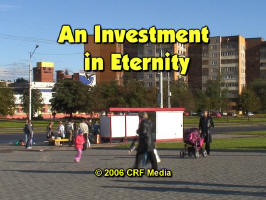 An
Investment for Eternity: 10:10
(HD-720;
mp4-SW;
mp4-LW;
Script) The Belarusians are much like you and I … a friendly people
who are concerned for their families and those about them. They
are also a people who have been victims of tragic world events …
events that have left scars on the land and on the people. Growing
up, the people of Belarus learn that to be a true Belarusian is to
be Russian Orthodox.
Of course, Orthodox churches abound but these buildings are
not important in their lives. The buildings, the icons inside and
the worship rituals do not offer the eternal hope that can be
found only in trusting Jesus Christ as their savior. An
Investment for Eternity: 10:10
(HD-720;
mp4-SW;
mp4-LW;
Script) The Belarusians are much like you and I … a friendly people
who are concerned for their families and those about them. They
are also a people who have been victims of tragic world events …
events that have left scars on the land and on the people. Growing
up, the people of Belarus learn that to be a true Belarusian is to
be Russian Orthodox.
Of course, Orthodox churches abound but these buildings are
not important in their lives. The buildings, the icons inside and
the worship rituals do not offer the eternal hope that can be
found only in trusting Jesus Christ as their savior.
|
The Oblasts of Belarus
During the Soviet rule, the country was divided into six
administrative districts known as Oblasts. These are: Minsk,
Vitebsk, Gomel, Mogilev, Brest, and Grodno.
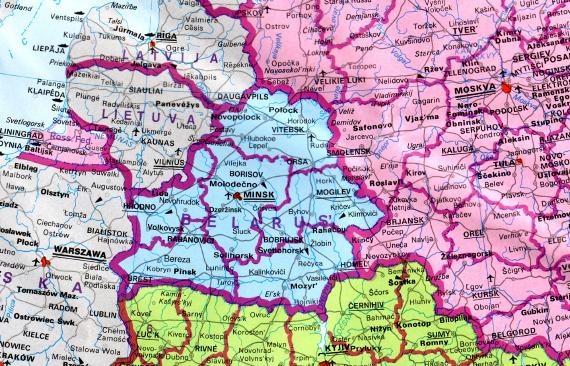 MINSK:
4:32 (HD-720;
mp4-SW;
mp4-LW;
Script)
The city of Minsk, with a population of about 2 million is by far
the largest city in the country and is an independent
administrative unit. This is also a showplace city. The well
maintained streets, the new busses, trolleys, and trams as well as
the shopping centers and office buildings exude an air of
prosperity. MINSK:
4:32 (HD-720;
mp4-SW;
mp4-LW;
Script)
The city of Minsk, with a population of about 2 million is by far
the largest city in the country and is an independent
administrative unit. This is also a showplace city. The well
maintained streets, the new busses, trolleys, and trams as well as
the shopping centers and office buildings exude an air of
prosperity.
|
|
Living Beyond
Calamities of the Past
The
Belarusian’s are survivors. They have survived the long history
of domination by outside influences; of being trampled upon like a
doormat. The bright colorful flowerbeds that bloom along the
streets and in city parks are symbolic of the peace and
tranquility that Belarusian’s value most.
|
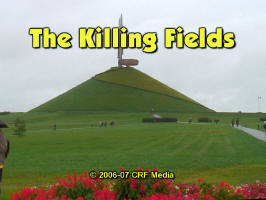 The Killing Fields:
3:16 (HD-720;
mp4-S;
mp4-SW;
mp4-L;
Script) Further down
the road is a different kind of monument that is visited by few
and represents a dark time in Belarus; a time that began in 1937
and ended in 1941 when Hitler’s army attacked the Soviet Union.
It was during this time, prior to the Great Patriotic War, that
Stalin used the Kurapaty Forests as a killing field. During this
period, each day the NKVD …. The Killing Fields:
3:16 (HD-720;
mp4-S;
mp4-SW;
mp4-L;
Script) Further down
the road is a different kind of monument that is visited by few
and represents a dark time in Belarus; a time that began in 1937
and ended in 1941 when Hitler’s army attacked the Soviet Union.
It was during this time, prior to the Great Patriotic War, that
Stalin used the Kurapaty Forests as a killing field. During this
period, each day the NKVD …. |
|
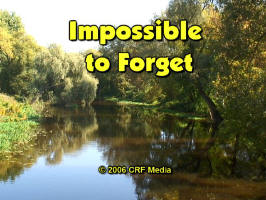 Impossible to Forget: 5:23
(HD-720;
mp4-SW;
mp4-LW;
Script)
The surprise attack on the Brest Fortress was the beginning
of Hitler’s invasion of the Soviet Union. He had over 3 million
well-trained and equipped solders positioned along a 1500-mile
front that extended from the Baltic in the North to the Black Sea
in the South. Hitler planned a quick knockout blow within a
matter of weeks. However, these plans did not expect the heroic
and sacrificial response presented by the Soviet defenders. Impossible to Forget: 5:23
(HD-720;
mp4-SW;
mp4-LW;
Script)
The surprise attack on the Brest Fortress was the beginning
of Hitler’s invasion of the Soviet Union. He had over 3 million
well-trained and equipped solders positioned along a 1500-mile
front that extended from the Baltic in the North to the Black Sea
in the South. Hitler planned a quick knockout blow within a
matter of weeks. However, these plans did not expect the heroic
and sacrificial response presented by the Soviet defenders.
|
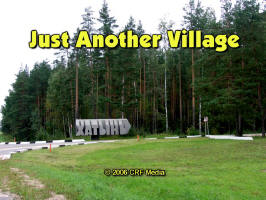 Just Another Village:
5:43
(HD-720;
mp4-SW;
mp4-LW;
Script) There are no
houses … just chimneys where homes once stood … 23 in all; a
stylized representation of wells that once supplied water to the
homes … gates connecting to the concrete walkways where roads once
were … all a drab gray, the color of ashes from a fire. Nearby,
is the representation of the roof of a barn. The sounds of
village life are replaced by the solemn peal of bells mounted on
the top of each chimney. Just Another Village:
5:43
(HD-720;
mp4-SW;
mp4-LW;
Script) There are no
houses … just chimneys where homes once stood … 23 in all; a
stylized representation of wells that once supplied water to the
homes … gates connecting to the concrete walkways where roads once
were … all a drab gray, the color of ashes from a fire. Nearby,
is the representation of the roof of a barn. The sounds of
village life are replaced by the solemn peal of bells mounted on
the top of each chimney. |
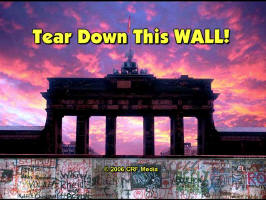 TEAR DOWN THIS WALL!:
11:38
(HD-720;
mp4-SW;
mp4-LW;
Script) For the
Orthodox Church, it is only 9 days until Easter. But, in the
dark of this night, an unauthorized test on the #4 nuclear reactor
at Chernobyl was under way. The crew had disabled emergency backup
equipment and turned off warning alarms. This one thousand
megawatt nuclear power generator located just south of the Belarus
border in Ukraine used highly flammable graphite for the
moderator. Then as these misguided tests continued to drive the
nuclear reactor well beyond safety margins …. TEAR DOWN THIS WALL!:
11:38
(HD-720;
mp4-SW;
mp4-LW;
Script) For the
Orthodox Church, it is only 9 days until Easter. But, in the
dark of this night, an unauthorized test on the #4 nuclear reactor
at Chernobyl was under way. The crew had disabled emergency backup
equipment and turned off warning alarms. This one thousand
megawatt nuclear power generator located just south of the Belarus
border in Ukraine used highly flammable graphite for the
moderator. Then as these misguided tests continued to drive the
nuclear reactor well beyond safety margins …. |
The Belarusians of Today
Over 70% of
Belarusian’s live in urban areas. Most live in the vast
apartment complexes. In the rural areas, the horse drawn plow is still a part of life
on the small farms. The older homes are wood frame construction.
Some are showing signs of decay while others look like new.
Usually, at least one Orthodox Church is in each community even
though it may be small and seldom attended by the residents.
|
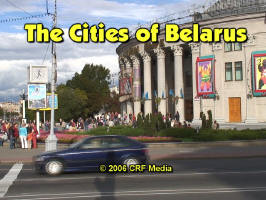 Cities
of Belarus: 8:23 (HD-720;
mp4-SW;
mp4-LW;
Script)
The cities of Belarus are a place to enjoy, a place for the very
young, a place to begin life together, a place to grow old and a
place to die. The open-air markets and other shopping areas are
where people of all ages can be found. For some, shopping
appears to be an effort. For others, it is an opportunity to
check out the latest gadgets. But for a child, the real treat is
sitting on the back of a pretend horse with his grandmother at his
side. Cities
of Belarus: 8:23 (HD-720;
mp4-SW;
mp4-LW;
Script)
The cities of Belarus are a place to enjoy, a place for the very
young, a place to begin life together, a place to grow old and a
place to die. The open-air markets and other shopping areas are
where people of all ages can be found. For some, shopping
appears to be an effort. For others, it is an opportunity to
check out the latest gadgets. But for a child, the real treat is
sitting on the back of a pretend horse with his grandmother at his
side. |
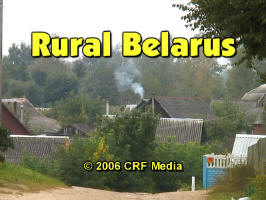 Rural
Belarus: 7:20
(HD-720;
mp4-SW;
mp4-LW;
Script)
Smoke from cooking and heating fires is part of life in rural
Belarus. As cold weather approaches, firewood is cut and stacked
in preparation for the long winter. Often this involves the
entire family as does harvesting hay to feed the cattle, horses,
sheep and goats. Just as in the earlier times, gardens are an
important part of surviving. They provide food for
summer as well as winter and are always carefully .. Rural
Belarus: 7:20
(HD-720;
mp4-SW;
mp4-LW;
Script)
Smoke from cooking and heating fires is part of life in rural
Belarus. As cold weather approaches, firewood is cut and stacked
in preparation for the long winter. Often this involves the
entire family as does harvesting hay to feed the cattle, horses,
sheep and goats. Just as in the earlier times, gardens are an
important part of surviving. They provide food for
summer as well as winter and are always carefully .. |
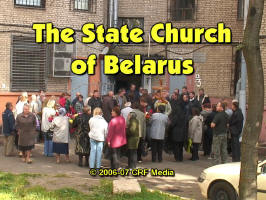 The
State Religion of Belarus: 6:10 ((HD-720;
mp4-SW;
mp4-LW;
Script) Eleven
centuries ago Grand Prince Vladimir of Kiev chose Greek Orthodoxy
instead of Roman Catholicism and Islam. Upon his baptism, the
Orthodox Church became the State Church of Russia. Today, the
Orthodox Church is the dominant religious institution of this
country despite the significant decline during the 70 years of
Communist rule. The fall of the Soviet Union in 1991 allowed
Belarus to become a country independent from Russia. With the
support of the government, the Orthodox Church regained much of
its prominence and today about 80% of the Belarusians claim the
Orthodox faith. The
State Religion of Belarus: 6:10 ((HD-720;
mp4-SW;
mp4-LW;
Script) Eleven
centuries ago Grand Prince Vladimir of Kiev chose Greek Orthodoxy
instead of Roman Catholicism and Islam. Upon his baptism, the
Orthodox Church became the State Church of Russia. Today, the
Orthodox Church is the dominant religious institution of this
country despite the significant decline during the 70 years of
Communist rule. The fall of the Soviet Union in 1991 allowed
Belarus to become a country independent from Russia. With the
support of the government, the Orthodox Church regained much of
its prominence and today about 80% of the Belarusians claim the
Orthodox faith. |
|
|
|
Statement
About Video Use
The videos produced by
CRF Media are to be used as a resource material for increasing
the awareness of and involvement with the specific
people groups featured in the material.
Please share these videos with others but
with the stipulation that they be free of all costs to the recipient.
Also, observe our copyright restrictions of not altering the files in
any way.
CRF Media
U.S. copyright
laws protect all media material produced by CRF Media. The files downloaded from this site may be copied and
distributed to others provided they are given
free of all charges
and they are
distributed in their
original form. Fragmentation
of the material is strictly forbidden without written permission
from CRF Media.
Go to
www.crfmedia.com for
information about receiving the
"The
Belarusians : A People Seeking Hope"
DVD.
Contact us for more information.
|
|
|











